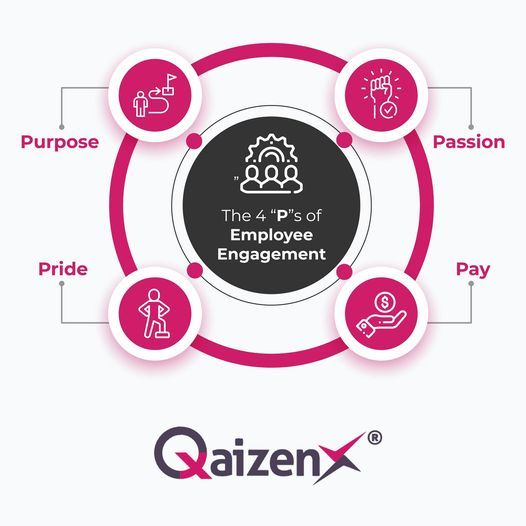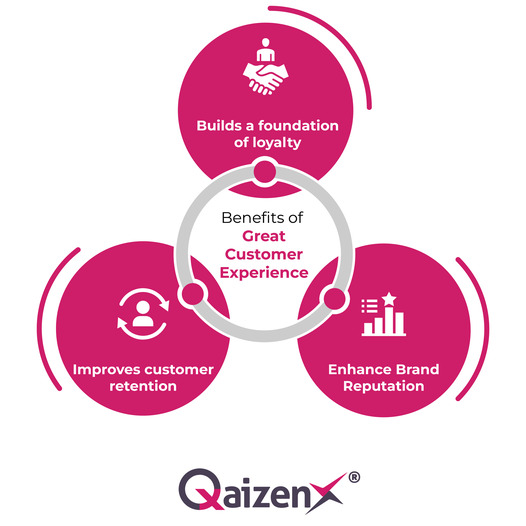Don't wanna be here? Send us removal request.
Text
Enhancing Customer Experience Through Diversity and Inclusion

At QaizenX, we believe in the power of diversity and inclusion to create exceptional customer experiences. Our approach focuses on fostering a welcoming environment where everyone feels valued and respected.
Through bias training and inclusive recruitment practices, we ensure that our team reflects a diverse range of perspectives and backgrounds. Employee resource groups further support our commitment to inclusivity, fostering collaboration and positive change.
Our leadership promotes diversity in decision-making, leading to innovative solutions that resonate with our diverse customer base. By regularly measuring our progress and celebrating successes, we continuously improve our efforts and maintain a culture of inclusivity.
Join QaizenX in embracing diversity and inclusion for happier employees and satisfied customers. Together, we can create a workplace and customer experience that reflects the rich tapestry of humanity.
#qaizenx#customersatisfaction#customerfeedback#customerexperience#customerloyalty#customerexcellence#cx#consumerfeedback#customercare#employeeexperience
0 notes
Text
Unlocking Happiness: Strategies for a Happy Workplace in the Digital Age

Are you looking to enhance the well-being and happiness of your employees in today's digital age? Look no further! Our blog post "Employee Well-being in the Digital Age: Strategies for a Happy Workplace" delves into essential strategies aimed at fostering a positive work environment.
In a world where remote work and constant connectivity are the norm, prioritizing employee well-being has never been more critical. From promoting work-life balance to encouraging open communication, our blog explores a range of strategies designed to ensure your employees feel valued and content in their roles.
By implementing these strategies, organizations can create a workplace where employees thrive, leading to increased productivity, job satisfaction, and overall success. Don't miss out on the opportunity to prioritize your employees' well-being and create a happy workplace environment.
Read the full blog post Employee Well-being in the Digital Age: Strategies for a Happy Workplace and discover how you can transform your workplace into a hub of positivity and productivity.
#qaizenx#customersatisfaction#customerfeedback#customerexperience#customerloyalty#customerexcellence#consumerfeedback#cx#customercare#employeeexperience
0 notes
Text
Empowering Employees: A Step-by-Step Guide

Are you interested in learning how to Employees Empowerment? Well, you're in the right place! Empowering employees means giving them the tools, resources, and support they need to take ownership of their work and contribute to the success of the team. Here's a step-by-step guide to help you empower employees in your workplace:
Set Clear Expectations: Start by setting clear expectations for your employees. Let them know what is expected of them in terms of their roles, responsibilities, and goals. When employees know what is expected of them, they can better focus their efforts and work towards achieving those expectations.
Provide Training and Development: Invest in training and development opportunities for your employees. This could include providing workshops, seminars, online courses, or on-the-job training. When employees have the skills and knowledge they need to excel in their roles, they feel more confident and empowered to take on new challenges.
Encourage Open Communication: Foster a culture of open communication where employees feel comfortable sharing their ideas, concerns, and feedback. Encourage regular one-on-one meetings, team meetings, and feedback sessions to keep the lines of communication open. When employees feel heard and valued, they are more likely to be engaged and motivated in their work.
Delegate Responsibility: Delegate responsibility to your employees and give them the autonomy to make decisions and take ownership of their work. Empower them to problem-solve and find creative solutions to challenges that arise. When employees feel trusted and empowered to make decisions, they are more invested in the success of the team.
Recognize and Reward Achievement: Recognize and reward employees for their hard work, achievements, and contributions to the team. This could be through verbal praise, public recognition, or tangible rewards such as bonuses, promotions, or extra time off. When employees feel appreciated and valued, they are motivated to continue performing at their best.
Lead by Example: As a leader, lead by example and demonstrate the behaviors and attitudes you want to see in your employees. Show empathy, integrity, and a willingness to listen and learn. When employees see their leaders embodying these qualities, they are inspired to do the same.
Empowering employees is not only beneficial for them individually but also for the overall success and growth of the organization. By following these steps and creating a culture of empowerment in your workplace, you can unlock the full potential of your employees and achieve greater success together!
qaizenx
#qaizenx#customersatisfaction#customerfeedback#customerexperience#customerloyalty#employeeexperience#customerexcellence#consumerfeedback#cx#customercare
0 notes
Text
Your 360 Degree Employee Assessment Guide By QaizenX
Welcome, to an immersive exploration of the Guide to Employee Assessments. As we step into the vast terrain of professional development. Our focus sharpens on the 360-degree assessment process—a transformative tool poised to redefine our understanding of workforce dynamics. Our article on employee assessment aims to cover not just the what, but the why and how behind the scenes of employee evaluations. By the end of this guide, you’ll not only comprehend the significance of 360-degree assessments but also glean insights into maximizing their potential for fostering a culture of continuous improvement within your team.
What is 360-Degree Assessment?
In today’s ever-changing business world, the 360-degree employee assessment acts like a guide, giving us a broad look into how each person is doing at work. Old ways of evaluating, where only the manager’s opinion mattered, are not as good as this new 360-degree method. This way goes beyond the usual and collects thoughts from different places, like coworkers, those working under the person, and even the person being evaluated. This wider view helps create a detailed picture of what someone is good at and where they can improve, going beyond just one viewpoint.
Why 360- Degree Employee Assessment is Important?
The 360-degree employee assessment is really important in today’s workplaces for a few key reasons. First off, it gives a complete and wide-ranging look at how a person is doing, going beyond the old way of just listening to the manager. It includes feedback from colleagues, those working under the person, and even from the person themselves. This helps create a fuller picture of what someone is good at and where they can do better. By bringing in different viewpoints, it helps us truly understand and appreciate what each employee experience brings to the table.
Keeping feedback anonymous helps people speak openly, making a space where truthful ideas can grow. This honesty is super useful to find places where we need to get better that might be missed in regular evaluations. Also, the 360-degree assessment supports a culture of always getting better by giving helpful ideas and encouraging a mindset of growth. It connects personal growth with what the company wants to achieve, making sure the assessment really helps the whole company succeed. So, in the end, the 360-degree employee assessment is like a powerful tool guiding everyone’s growth in the always-changing workplace.
The Steps to a Comprehensive Assessment:
1. Setting the Stage:
In our guide to a complete 360-degree assessment, the first thing we do is set the stage, much like laying the foundation for a big building. This step is not just about starting a process; it’s about planning what it’s all for. We need to have a deep talk about what we want to achieve—is it about each person getting better, making the team work together smoothly, or checking how everyone is doing overall? By figuring out these goals, we create a clear plan that helps the assessment fit into the bigger picture and goals of our organization.
2. Selecting Evaluators:
Now, let’s dive deeper into the 360-degree assessment by talking about choosing the people who will give feedback. It’s crucial to pick a diverse group, meaning different kinds of people, to get a well-rounded view. Diversity is like the key that makes the assessment really detailed and fair. We don’t just randomly choose people; it’s a thoughtful selection, picking voices from various parts of the company. This careful diversity makes sure the evaluation isn’t just from one perspective. It’s like having a colorful picture that shows all the different sides of your organization.
3. Anonymous Feedback:
In 360-degree assessments, people need to be honest, and one way to make that happen is through anonymous feedback. This means the feedback is given without knowing who said it. This decision is a big deal because it helps break down barriers, letting those giving feedback say exactly what they think. It goes beyond rehearsed or planned talks, creating a space where people can share what they feel. The difference between anonymous and attributed feedback is like the difference between reading from a script and having a real, open conversation. This choice can make a big difference in how helpful and genuine the insights we get are.
4. Data Collection and Analysis:
Now, after collecting information, we move on to the next part of our assessment adventure – the analytical stage. It’s like putting on our thinking caps. The assessments are not just numbers; they’re like a bunch of stories waiting to be uncovered. This analytical journey is more than just looking at numbers; it’s like carefully understanding the tales hidden in the feedback. It’s turning raw data into a symphony of useful information – a process that needs not only good math skills but also a sharp understanding of the stories hidden in the feedback.
5. Feedback Session:
Moving from studying to doing, armed with lots of helpful information, we now enter the special world of the 360-degree feedback session. Here, the focus isn’t on giving judgments but on making a safe space for open talk. It’s like a place where we cheer for the good things just as much as we talk about ways to get even better. This careful balance helps everyone think about growing and getting better together. The assessment turns into more than just a way to measure things – it becomes a spark for each person and the whole team to keep improving. The session is like a team journey, where ideas mix and shape the ongoing story of getting better.
Conclusion
Now, let’s think about what we’ve learned about 360-Degree Employee Assessment. Imagine we’re closing a book on this adventure. It’s like when we close the curtains after watching a play. This assessment thing is like a guide or a compass. It helps people and companies figure out where to go for success. It’s not just a stop on a work journey; it’s more like a tool that helps everyone get better. What we discover and discuss in assessments are puzzle pieces forming progress. So, remember, it’s not the end of the story; it’s just the beginning. It’s like a starting point for getting better and growing in your work world.

#qaizenx#customersatisfaction#customerfeedback#customerexperience#customerloyalty#employeeexperience
0 notes
Video
How to Engage Your Employees - QaizenX Employee Experience
0 notes
Text

#EmployeeEngagement#EmployeeHappiness#EmployeeSatisfaction#EmployeePulseSurvey#Employees#EngagedEmployees#HR#WorkCulture#EngagementStrategy#eNPS#QaizenX
2 notes
·
View notes
Text

#MarketResearch#ProductMarketResearch#IdeaTesting#BusinessModelTesting#MarketResearcher#MarketAnalysis#ProductMarketFit#Startup#ConceptTesting#NewProduct#NewProductLaunch#Feedback#Survey#ConceptValidation#QaizenX
1 note
·
View note
Text

#GreatCustomerExperience#CustomerLoyalty#CustomerSatisfaction#CustomerHappiness#CustomerExperience#CustomerFeedback#CustomerSentiments#CustomerOpinion#ConsumerFeedback#CustomerExcellence#QaizenX
1 note
·
View note
Text

#CX#CustomerRetention#CustomerSatisfaction#CustomerJourney#CustomerHappiness#CustomerExperience#CustomerFeedback#CustomerEngagement#CustomerCare#Customers#CustomerFirst#CustomerExcellence#CustomerLoyalty#GrowBusiness#QaizenX
0 notes
Text

#CX#JeffBezos#JeffBezosQuotes#CustomerExperience#CustomerExperienceQuotes#Quotes#CustomerSuccess#GoodFitCustomers#CustomerSatisfaction#CustomerHappiness#CustomerFeedback#CustomerEngagement#CustomerCare#Customers#CustomerFirst#CustomerExcellence#CustomerLoyalty#GrowBusiness#QaizenX
2 notes
·
View notes
Text

#GettoKnowYourCustomersDay#ThankYou#Customers#CustomerCentricity#ClientAppreciation#CustomerExperience#CustomerSatisfaction#CustomerAppreciation#Growth#QaizenX
1 note
·
View note
Text

#CES#CustomerEffortScore#CustomerEffort#CxStrategy#EffortlessExperience#Review#Feedback#Survey#HappyCustomers#CustomerService#CustomerFeedback#ConsumerFeedback#QaizenX
1 note
·
View note
Text

#EmployeeRetention#RetentionStrategy#EmployeeExperience#EmployeeTurnover#EmployeeEngagement#EmployeeAppreciation#CareerManagement#Employees#EX#HR#WorkCulture#Leadership#eNPS#QaizenX
1 note
·
View note
Text

#CustomerExperience#CustomerChurnRate#CustomerSatisfaction#CustomerLoyalty#CustomerSuccess#CustomerCare#CustomerCentric#Customer#CustomerFeedback#ConsumerFeedback#CustomerExcellence#CX#QaizenX
1 note
·
View note
Text

#CandidateExperience#ProductExperience#CustomerEngagement#EmployeeEngagement#EmployeePulse#Management#Experience#CX#EX#brand#data#people#QaizenX
1 note
·
View note

